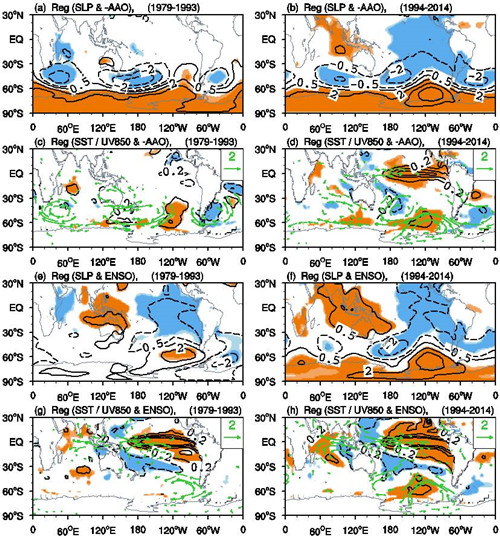IAP Finds Strengthened Relationship between the AAO and ENSO
Date:2016-10-12
The Antarctic Oscillation (AAO), the principle mode of circulation in the Southern Hemisphere (SH), is primarily characterized by a large-scale seesaw oscillation of air masses between the Antarctic and midlatitudes. ENSO, meanwhile, is considered the most striking interannual climate variation over the Pacific. Previous studies have suggested that the AAO and ENSO are not two independent physical processes.
In a study recently accepted for publication in Advances in Atmospheric Sciences (Han et al., 2017), scientists from Institute of Atmospheric Physics/Chinese Academy of Sciences, investigated a decadal strengthened relationship between ENSO and the AAO in austral spring after the mid-1990s, based on both reanalysis data and numerical experiments. Composite and regression analyses showed their correlation to be statistically insignificant during 1979–93 (P1), but significant during 1994–2014 (P2).

The simultaneous (a, b) SLP (units: hPa) and (c, d) SST (contours; units: °C) / UV850 (vectors; units: m s?1) regressions onto the austral spring –AAO index during 1979–93 (left panels) and 1994–2014 (right panels). (e–h) As in (a–d) but for the austral spring Ni?o3.4 index. Vector winds are significant at the 90% confidence level, based on the Student’s t-test. The dark (light) shaded regions represent the 95% (90%) confidence level, respectively, as estimated using the Student’s t-test (Han et al., 2017).
During P1, the ENSO (AAO) spatial signatures were restricted to the tropics–midlatitudes (Antarctic–midlatitudes) of the SH, with a weak connection between the two oscillations. Comparatively, after the mid-1990s, the El Ni?o-related atmospheric anomalies projected on a negative AAO pattern with a barotropic structure in the mid–high latitudes of the SH. The expansion of El Ni?o–related air temperature anomalies has had a heightened impact on the meridional thermal structure of the SH, contributing to a weakened circumpolar westerly and strengthened subtropical jet. Meanwhile, the ENSO-related southern three-cell circulations expanded poleward and then strongly coupled the Antarctic and the tropics.Numerical simulation results suggested that the intensified connection between ENSO and SST in the South Pacific since the mid-1990s was responsible for the strengthened AAO–ENSO relationship.
Reference
Han, T. T., H. J. Wang, and J. Q. Sun, 2017:Strengthened relationship between the Antarctic Oscillation and ENSO after the mid-1990s during austral spring. Adv. Atmos. Sci., doi: 10.1007/s00376-016-6143-6 in press. http://159.226.119.58/aas/EN/10.1007/s00376-016-6143-6
Contact: HAN Tingting, hantt08@126.com
